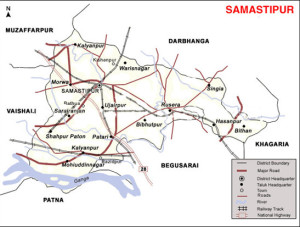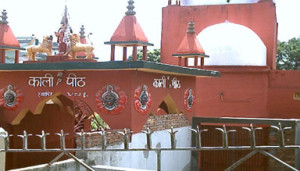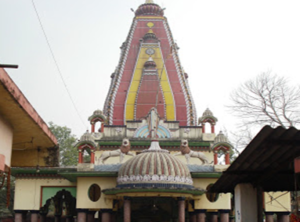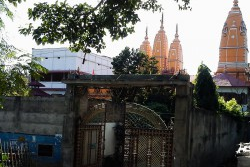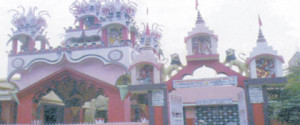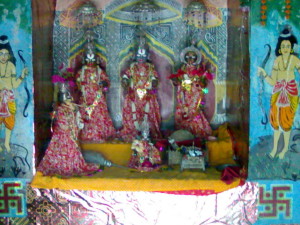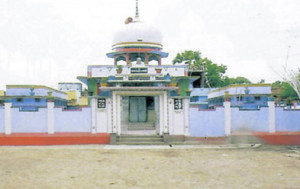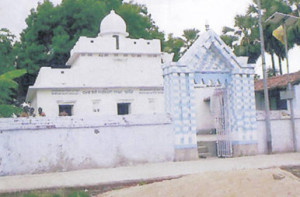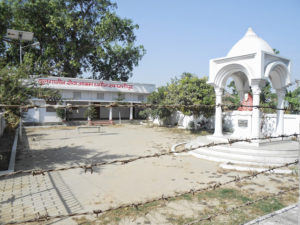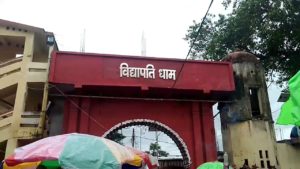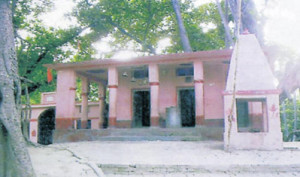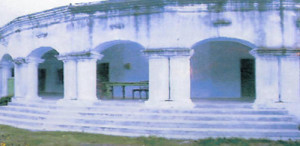SAMASTIPUR DISTRICT
How To Reach
By Airport :-
Nearest airport location is Patna.
By Rail :-
It is the Divisional Headquarters of the East Central Railway.
By Road :-
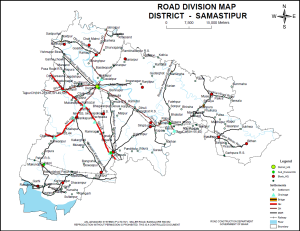 Well connected to other city through National Highway -28,103 State Highway-49,50,55 and other road-Dholi Kalyanpur Road,Rosera Hathauri Kothi Road,Samastipur Dalsingsarai Road,Muzaffarpur Samastipur Road,Hasanpur Bithan Road,Vidyapati Kakarghati Road,Madudabad Patori Road,Singhia Hirani Road.
Well connected to other city through National Highway -28,103 State Highway-49,50,55 and other road-Dholi Kalyanpur Road,Rosera Hathauri Kothi Road,Samastipur Dalsingsarai Road,Muzaffarpur Samastipur Road,Hasanpur Bithan Road,Vidyapati Kakarghati Road,Madudabad Patori Road,Singhia Hirani Road.
Samastipur is around 82 KM from Patna.
Popular tourist destinations
SAMASTIPUR BLOCK
Old Kali Mandir(Samastipur):-
Thaneshwar Temple(Samastipur):-
Thaneshwar Temple is a very famous tample of Lord Shiva, and is situated at the heart of the city. The name derived from the Thana(police station) and ishwar (God) ie Thaneshwar Mandir.
Khatushyam Temple:-
It is located close to Gola Road. It is dedicted to Lord Krishna.
Musrigharari: –It is situated 8 km from Samastipur main town on NH 28. This place is very famous for its Muharram and Durga Puja Celebration.
Khanqah E Aalia Quadria (Chausima bejha):-
AASTANA Khairul Atqia Sufi Basifa HAZRAT SYED SHAH MOHAMMED UMAR ALI QUADRI R.A Sahab e Sajjada
SYED GHULAM MUHIUDDIN QUADRI mada zillahul aali
Dihwarnisthan (Bakhribuzurg): – It is situated at a distance of about 500 meters from Musrigharari main market beside NH 28. Bakhari Buzurg is rich in agriculture because of its fertile plain. Tobacco, maize, rice and wheat are the main crops. Dihwarnisthan is the famous mandir with great religious belief. It is the open pind temple. It is said all wish are fulfilled here.
Bhagwati Sthan (Durga Mandir) (Mannipur): –
It is situated 2 km from Samastipur main town .This place is famous for Durga Mata and their blessings. It is said that it is more than 200 years old temple.
Kewas Nizamat:- As per exploration done by KP Jayaswal Research Institute marked Period of site as NBPW phase. Kewas Jagir:- As per exploration done by KP Jayaswal Research Institute marked Period of site as NBPW phase. Bejha Dih:- As per exploration done by KP Jayaswal Research Institute marked Period of site as NBPW phase. Chak Nur:- As per exploration done by KP Jayaswal Research Institute marked Period of site as NBPW phase. Dudhpura (Dadpur):- As per exploration done by KP Jayaswal Research Institute marked Period of site as NBPW phase. Nageshwar Jyotirling (Kewas):- As per exploration done by KP Jayaswal Research Institute marked Period of site as Medieval. Dhurlakh:- As per exploration done by KP Jayaswal Research Institute marked Period of site as Early medieval. Jitwarpur Dih:- As per exploration done by KP Jayaswal Research Institute marked Period of site as Early medieval. Bari Punas:– As per exploration done by KP Jayaswal Research Institute marked Period of site as Early medieval.
Mauriyadiwa (Mordih):- As per exploration done by KP Jayaswal Research Institute marked Period of site as Early medieval.
Mordiwa: – It has newly rebuilt Thakurbari.
Pitaunjia:- Pitaunjia, now known as karpoorigram is birthplace of Bihar ex-chief minister Karpoori Thakur. Karpoori Thakur (24 January 1924 – 17 February 1988) was an Indian politician from the Bihar state. He was popularly known as Jan Nayak.
As a student activist, he left his graduate college to join the Quit India Movement. For his participation in the Indian Independence Movement, he spent 26 months in prison. After India gained independence, Thakur worked as a teacher in his village’s school. He became a member of the Bihar Vidhan Sabha in 1952. Thakur served as a minister and Deputy Chief Minister of Bihar , before becoming the first non- Congress socialist Chief Minister of Bihar in 1970 to June 1971. He also enforced total prohibition of alcohol in Bihar. He was close to Jaya Prakash Narayan .During the emergency in India (1975–77), he and other prominent leaders of Janata Party led the “Total Revolution” movement aimed at non-violent transformation of the Indian society. After the Janata Party came to power, he won the chief ministership battle from the then Bihar Janata Party President Satyendra Narayan Sinha to become the Bihar Chief Minister for a second term in 1977. However he could not last his full term because he lost the leadership battle in 1979 from Ram Sundar Das whom his adversaries placed against him and was replaced as chief minister. He introduced reservation for the backward classes in the Government jobs, in 1978. M.S. KARPURI GRAM SCHOOL was established in year 1942.
KALYANPUR BLOCK
Mahadeo Temple (Malinagar): –
It is situated 35 km south- west of Laheriasarai(Darbhanga) in Kalyanpur Block, famous for temple of Mahadev which was built in 1844 by a local businessman. The height of Shiva Lingam is almost 5 feet. A fair is held here every year on the eve of Ramnavami. It is the birthplace of Hindi literature Grate writer Babu Devkinandan khatree.
Harpur Mahamada: –
It is located 16 KM towards west from District head quarters Samastipur and 77 KM from State capital Patna. It is a big village . It is situated on the bank of river ‘Budhi Gandak’.The Mahamada village is famous for its development in Pusa block and sets an example for other village. People from all castes and religions live peacefully in the village.It was famous for its landlords in colonial era. It had a famous garden(known as ‘Phulwari’). People from distant places used to come and visit the famous garden. The village has high literacy rate. The village has produced a large number of freedom fighters,engineers,doctors,army personnel(Officers,JCOs,ORs),educationalists,public servants,political leaders and personality from all sorts of life.
Most recently, the brave son of the village Late Lieutenant Amit Prasad Singh sacrificed his life in the war of Kargil fighting against enemies.
There are many Takurbari in this villge. The village has all modern facilities like a petrol pump(aside of CHAUDHARY TOLA), LPG agency, cold storage facility, drinking water supply facility, bank, post office, automobile showrooms, schools, library, hospital, cinema hall etc.
Lt. Amit Singh Bhavan Asmita (Mahmada): –
With a carpet area of about 3,500 sq ft. which will have hall for medication, office and space for staying. The house was dedicated to the nation on 6th March, 2009 as THE HOME OF MARTYRS.
Pusa:- In the imperial Gazetteer of India 1878, Pusa was recorded as a government estate of about 1350 acres in Darbhanga dist. Land was acquired by East India Company for running a stud-farm to supply better breed of horses for the army but after ninety years in 1874, Stud Farm was closed due to epidemic gland disease. A British tobacco concern Beg Sutherland & co. got the estate on lease but it also left in 1897 abandoning the government estate of Pusa. Lord Mayo, The Viceroy and Governor General, had been repeatedly trying to get through his proposal for setting up a directorate general of Agriculture that would take care of the so and its productivity, formulate newer techniques of cultivation, improve the quality of seeds and livestock and also arrange for imparting agricultural education.
The government of India had invited a British expert. Dr. J.A. Voelcker who had submitted as report on the development of Indian agriculture. As a follow-up action, three experts in different fields were appointed for the first time during 1885 to 1895 namely, Dr. J.W.Leafer (Agricultural chemist),Dr. R.A.Butler (Cryptogamic Botanist) and Dr. H.Maxwell Lefroy (Entomologist ) with headquarters at Dehradun (U.P.) in the forest Research Institute complex.In 1898 Viceroy Lord Curzon salvaged out the earlier proposal and got London’s approval for the appointment of the inspector General of Agriculture. As the first incumbent Mr. J. Mollison (Dy. Director of Agriculture, Bombay) joined in 1901 with headquarters at Nagpur.In 1902 The then government of Bengal send a proposal to the centre for setting up a model cattle farm at Pusa estate where plenty of land, water and feed would be available, and with Mr. Mollison’s support this was accepted in principle.Before the above proposal could be implemented, certain interesting developments had taken place which brought Pusa directly in the limelight in the history of agriculture of modern India. Probably the most important one was donation of $30,000 by an American, Mr. Henry Phipps of Chicago, family friend of Viceroy Curzon. In the words of Lord Curzon , the amount had been offered to him by the donor for utilizing it in whatever way he desired. The decision of Lord Curzon went in favour of agriculture. It is said that the name of the place Pusa is the abbreviated form of Phipps of U.S.A. (PUSA) but many people say that the name of the village Pusa existed even before.
Pusa became a nerve centre of future development of the country’s agriculture.The first Director, Mr. B.Coventry jointed on April 1, 1904. The foundation stone of the Agricultural Research Institute and college was laid by Lord curzon on the 1st of April, 1905. In his speech, the viceroy had expressed his vision that the seed he was planting would soon blossom out, making Pusa the nucleus of agricultural activities, research and education which would not only benefit Bihar and Bengal but the whole of the country and would attract the best of talents from India and abroad.
At the site of present sugarcane research institute at Pusa, once stood a magnificent two-storeyed gigantic structure in ornate range with flat roof surmounted by a massive dome known as Phipps laboratory. Phipps laboratory was also called as “Naulakha” building by local people. Quite a few renowned scientists arrived from England including an imperial agriculturist, and imperial economic botanist. Then came up the issue of starting the college. As per the original proposal (1903) the experts were assisted in the teaching programme by a number of junior teachers, instructors, field overseers etc. and some transferred from the shibpore (Kolkata) college which was not functioning well and was to be closed down.
So the original idea of undergraduate education at Pusa was changed over to an institute of postgraduates studies. In 1908-09, the first batch of students, for Licentiates in Agriculture were admitted. For the first time dissemination of important and practical results of research was taken up through Pusa Bulletins, memories of the department of agriculture, and the agricultural journal of India (1912). Rightfully, Pusa received an imperial status in 1918, being renamed as the Imperial Agricultural Research Institute (IARI).On 15 January 1934 at 2.00 PM devastating earthquake damaged the main building of the institute i.e. Phipps Laboratory and on 29th July 1936, Institute was shifted to Delhi. On 7th November 1936, new institute building was inaugurated at Delhi.
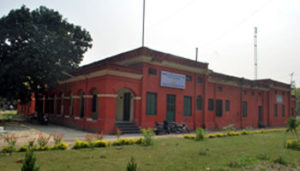 Pusa estate were then purchased by the government of Bihar at a nominal cost of RS. 205000, the Government of India still retaining a small unit called Botanical sub-station was left over at pusa Bihar to serve as regional station of its main research institute at New Delhi. In 1969, Botanical sub-station renamed as Regional Research Station and in 1975, Regional Research Station upgraded as IARI Regional Station, Pusa, Bihar. Pusa estate since its purchase by the Govt. of Bihar has undergone a series of changes with the dawn of independence and one finds today a number of institutions located here along with the sugarcane research institute which is the major scientific organization at Pusa and one of the biggest centres of sugarcane research in the country.The I.A.R.I., regional station located at Pusa had been working towards development of wheat varieties Tobacco Research Station at Pusa has also bred a good number of varieties of chewing tobacco and are popular in farmer’s field.
Pusa estate were then purchased by the government of Bihar at a nominal cost of RS. 205000, the Government of India still retaining a small unit called Botanical sub-station was left over at pusa Bihar to serve as regional station of its main research institute at New Delhi. In 1969, Botanical sub-station renamed as Regional Research Station and in 1975, Regional Research Station upgraded as IARI Regional Station, Pusa, Bihar. Pusa estate since its purchase by the Govt. of Bihar has undergone a series of changes with the dawn of independence and one finds today a number of institutions located here along with the sugarcane research institute which is the major scientific organization at Pusa and one of the biggest centres of sugarcane research in the country.The I.A.R.I., regional station located at Pusa had been working towards development of wheat varieties Tobacco Research Station at Pusa has also bred a good number of varieties of chewing tobacco and are popular in farmer’s field.
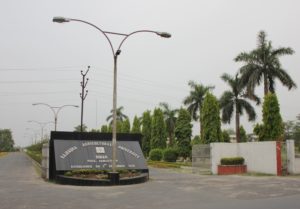 Now the Rajendra Agricultural University (RAU) has established (1970) itself at Pusa and has become an important landmark in agricultural research & education in the eastern region of the country. The Rajendra Agricultural University now at Pusa has various faculties and constituent colleges namely, Tirhut College of Agriculture (Dholi) Muzaffarpur, Bihar Agricultural college, Sabour (Bhagalpur), Bihar veterinary college, Patna, Sanjay Gandhi Institute of Dairy Technology, Patna, College of Fisheries, Dholi (Muzaffarpur) College of Home Science, College of Agricultural Engineering, College of Basic Sciences & Humanities and a postgraduate Faculty at Pusa. In RAU, M.Sc. Degree is awarded in 34 and Ph.D. in 17 disciplines. There is one central Library, one 450 seat capacity of Boy’s Hostel, one University Girl’s Hostel, a VIP Guest House, Kisan Ghar, IKH Bhawan, Sanchar Kendra, ATIC building, administrative complex, flax house & cluster of residential building. The old imperial time 14 bungalows & other residential quarters are still holding the ground with imperial touch.
Now the Rajendra Agricultural University (RAU) has established (1970) itself at Pusa and has become an important landmark in agricultural research & education in the eastern region of the country. The Rajendra Agricultural University now at Pusa has various faculties and constituent colleges namely, Tirhut College of Agriculture (Dholi) Muzaffarpur, Bihar Agricultural college, Sabour (Bhagalpur), Bihar veterinary college, Patna, Sanjay Gandhi Institute of Dairy Technology, Patna, College of Fisheries, Dholi (Muzaffarpur) College of Home Science, College of Agricultural Engineering, College of Basic Sciences & Humanities and a postgraduate Faculty at Pusa. In RAU, M.Sc. Degree is awarded in 34 and Ph.D. in 17 disciplines. There is one central Library, one 450 seat capacity of Boy’s Hostel, one University Girl’s Hostel, a VIP Guest House, Kisan Ghar, IKH Bhawan, Sanchar Kendra, ATIC building, administrative complex, flax house & cluster of residential building. The old imperial time 14 bungalows & other residential quarters are still holding the ground with imperial touch.
In present Pusa, apart from the University a number of other organization such as Regional Research Station of IARI, New Delhi., Tobacco Research Station of CTRI, Rajamundri, Crop Research programme of ICAR, Kisan Vidyapeeth, Women’s Teacher Training School, Campus Public School (affiliated to CBSE), Kendriya Vidyalaya, Rajendra Sishu Sadan, Govt. Basic School, Govt. High School, Govt.Girl’s High School, Uma Pandey College, Brahmdeo Rai Sharma Mahila Mahavidyalaya, Community Development Block, a referral hospital, Central Bank of India, Punjab National Bank, Cooperative Training Centre, Post and Telegraph Office, Office of Telecommunication & Pusa Police Station etc. are also functioning and contributing to the all round growth and development of Pusa Estate.
Kali Temple (Waini, Pusa)
The village is 1.50 km east from Khudiram Bose Pusa station. There is the oldest Kali Temple situated at Kayastha Tola in this village . As the temple is situated under the banyan tree which is the oldest.
Durga Mandir (Kessopatti): – It is one of the oldest temple. Every year on the eve of Durga Puja pilgrims come for worship
Lodi Peer Baba (deopar): – Deopar village is situated right next to the Pusa Agriculture University and is about 30 km from Muzaffarpur. Deopar is the birthplace of the famous freedom fighter from Pandit Yamuna Karjee. Deopar is full name Mohammadpur Deopar. There is near a mosque and a Mazar (Baba Lodi Peer) is the famous palace in Mohammad pur deopar.
Simria-Bhindi: – It is situated 7km away from sub-district headquarter Kalyanpur and 17km away from district headquarter Samastipur.
Sculptures of Vishnu and eight- armed Durga datable to late Pala Period was found in this village in year 74-75 by ASI.
There is a mound from which statue of octagonal Mahishasura Mardini (48 × 30 cm) made of black stone, statue of Umamaheshwar (44 × 20) in the posture of Lalitasan, damaged sculpture of Sun, old cuop, skeleton of deer and chaki and siloti are found.
Statue of Mahishasura Mardini is installed in installed installed a Bhagwati temple and sculpture of Sun is placed in the root of the tree.
Chandherpur:- As per exploration done by KP Jayaswal Research Institute marked Period of site as Late NBPW phase.
BIBHUTIPUR BLOCK
Manda:- As per exploration done by KP Jayaswal Research Institute marked Period of site as NBPW phase. Mustafapur:- As per exploration done by KP Jayaswal Research Institute marked Period of site as NBPW phase. Belasandi Dih:– As per exploration done by KP Jayaswal Research Institute marked Period of site as NBPW phase. Kishanpur Tabhka:- As per exploration done by KP Jayaswal Research Institute marked Period of site as NBPW phase. Ramgarh:– As per exploration done by KP Jayaswal Research Institute marked Period of site as Late medieval. Kalyanpur (Bishanpur):- As per exploration done by KP Jayaswal Research Institute marked Period of site as Early medieval. Shaikha Dih (Bazidpur, Bambaiyya):- As per exploration done by KP Jayaswal Research Institute marked Period of site as Early medieval. Bishunpur:_ As per exploration done by KP Jayaswal Research Institute marked Period of site as Medieval. Mahishi Dih:- As per exploration done by KP Jayaswal Research Institute marked Period of site as NBPW phase. Muslimpur:- As per exploration done by KP Jayaswal Research Institute marked Period of site as Early medieval.
Narwan:-
As per exploration done by KP Jayaswal Research Institute marked Period of site as Early medieval.
Narhan Estate:– It is located 30 KM towards East from District head quarters Samastipur, 8 KM from Bibhutpur and 103 KM from State capital Patna. There is a magnificent old Building of Narhan Estate, which has been very prominent in this area since the Mughal period. Narhan that provide the historical Dronwar Dynasty thirteen Bhuption developed it as a capital city.. At that time several Bridges, temples, forts constructed here. Lots of things in Estate (historyca and archaeologycai) are distributed and sifted to Benares. Chaos in the overland route from Samastipur in Rosdha Mahishasurmrdini Karnatkalin the sculpture has a fragmented, which is laid there with other antiquities.
According to Jayaswal Research Institute Archaeological Explorations this site belongs to Late Medieval period.
Jageshwar Asthan (Narhan raj mandir):-
It is an old Shiva temple It is situated about 15 km from Narhan Railway station. It is said that Jageshwar Devi, who is the daughter of Bhaw Mishra, the Vaidya of Narhan Estate, built this temple.
Ckakbideliya:- In the Chakbideliya Pala period temple in which Sun sculpture (two feet long), statues of Shiva and Nandi is installed.
MOHIUDDINAGAR BLOCK
Niranjan Swamy(Dhamoun):-
Saint Dariya Ashram (Dhamoun): –
Dariya Sahib of Bihar (1674-1780) was born at village Dharkandna in Arrah district near Dumraon. He was the son of Puran Shah (a Muslim of Ujjain) whose ancestors ruled Jagdishpur near Buxar. He is believed to be the incarnation of Kabir, who affirmed this to his mother when he was one month old, and it was Kabir who christened him as Dariya. His major works are Dariya Sagar and Gyan Deepak.
Quila of Mohiuddinnagar- Mohiuddinnagar tells the story of Mughal history. The story of Babar, Ruhele and Afghani is buried in ruins historic buildings. Babar when it took control of Delhi in 1526 AD Ruhele and Afghanistan spreadover to Bengal and Tirhut. When 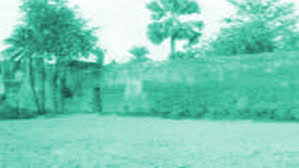 they ran toward Bihar the Nawab of Bengal Alivardi Khan gave him refuge. Ruhele the chief Shamsher Khan, became the main soldier of Alivardi Khan, but he was murdered by enemies. Consequently Alivardi khan took full accountability and married Shamsher Khan daughter Ayesha Khan to Shah Mohammed Asak. In farewell Alivardi khan gave them 20 villages in the province to used. Aisha Bibi fort was build in this land, which is now a ruins and tolled the history. Shah Mohammed Munauwvruddin tomb is located in the north of the Ayesha fort.On his name this place is named Mohiuddinnagar by Ayesha’s husband. Remains of Fasighar(hanging house) can be seen in the Ayesha fort. It is said that the conviction was given in this Fasighar that time. In addition to that Hazrat Shah Sarwar khanqahs and 1497 AD Built Iranian style mosque belonged to Lodi Vansh are here. The area located in the north-east of Fort Mohiuddinnagar market was called “government” that time. About 10ft high wall of Lakuri bricks are spread in vast area can be seen. Now a day The fort is in ruins. The door of the fort is in a dilapidated condition. Later there is a small gate erected by the people to protect the fort.. After the death of Aisha bibi his grandson Mohammed Hussain erected Tomb(Makbara) on her grave, but after a few month it appear that the roof of the tomb was lost in the rain. Shah Mohammad Hussein want to re-roofing it but in dreame any one is forbidden. Consequently the roof is left intact. Again came the era of Shah Mohammad Wajid Hussain. He erected the roof of thae Tomb but nest day it was seen that roof had fallen. Since then, no one ever did attempt to reconstruct the tomb. Such historical heritage has now turned into ruins.
they ran toward Bihar the Nawab of Bengal Alivardi Khan gave him refuge. Ruhele the chief Shamsher Khan, became the main soldier of Alivardi Khan, but he was murdered by enemies. Consequently Alivardi khan took full accountability and married Shamsher Khan daughter Ayesha Khan to Shah Mohammed Asak. In farewell Alivardi khan gave them 20 villages in the province to used. Aisha Bibi fort was build in this land, which is now a ruins and tolled the history. Shah Mohammed Munauwvruddin tomb is located in the north of the Ayesha fort.On his name this place is named Mohiuddinnagar by Ayesha’s husband. Remains of Fasighar(hanging house) can be seen in the Ayesha fort. It is said that the conviction was given in this Fasighar that time. In addition to that Hazrat Shah Sarwar khanqahs and 1497 AD Built Iranian style mosque belonged to Lodi Vansh are here. The area located in the north-east of Fort Mohiuddinnagar market was called “government” that time. About 10ft high wall of Lakuri bricks are spread in vast area can be seen. Now a day The fort is in ruins. The door of the fort is in a dilapidated condition. Later there is a small gate erected by the people to protect the fort.. After the death of Aisha bibi his grandson Mohammed Hussain erected Tomb(Makbara) on her grave, but after a few month it appear that the roof of the tomb was lost in the rain. Shah Mohammad Hussein want to re-roofing it but in dreame any one is forbidden. Consequently the roof is left intact. Again came the era of Shah Mohammad Wajid Hussain. He erected the roof of thae Tomb but nest day it was seen that roof had fallen. Since then, no one ever did attempt to reconstruct the tomb. Such historical heritage has now turned into ruins.
According to Jayaswal Research Institute Archaeological Explorations this site belongs to Medieval period.
Bulganin Seva Ashram:-
kali temple( Hrail ):-
Karim Nagar:- As per exploration done by KP Jayaswal Research Institute marked Period of site as Medieval. Andaur Dih:- As per exploration done by KP Jayaswal Research Institute marked Period of site as NBPW phase. Ramaiya:- As per exploration done by KP Jayaswal Research Institute marked Period of site as Early medieval. Mushahari Bhadaiyya:–As per exploration done by KP Jayaswal Research Institute marked Period of site as NBPW phase.
Khanqah Quadria (Peerganj):-
SAJJADA NASHIN:-
HAZRAT SYED SHAH ANWAR HUSSAIN QUADRI mada zillahul aali.
BHUTTU BABU.
HASANPUR BLOCK
Mangalgarh (Dhudapura):– It is Situated 14 kms from Hasanpur Block near Dhudapura village. Remains of the fort of king Mangaldeo have been discovered there. Loard Buddha stayed there and preach Buddhism for some time while going round the country at the request of King Mangaldeo. In the course of exploration done by ASI in year 1982-83, mound yielding northern black polished ware along with grey and black wares and a few terracotta figurines.
According to Jayaswal Research Institute Archaeological Explorations this site belongs to NBPW phase period.
Kumar Sangrahalay(Hasanpur):- Dr P.K.Singh ‘Maun’ collected numerous objects and artifacts and established kumar Sangrahalaya at his native village Hasanpur in year 1956. Here is rare collection of a number of antiquities mainly Mangalagarh, Pandav nagar, Marwani, Kumran of the distt, Chchar(Vaishali), Shree Nagar Garh(Saharsa), Chandi (West Champaran) Marang (Nepal) etc The museum collection contains a good number of terracottas, stone sclptures, paintings, manuscripts, coins and Mugal era remains that were found in the area.
Deodha( Holy Pilgrimage Of Dome): – It is located 41 KM towards East from District head quarters Samastipur. 10 KM from Hasanpur. 118 KM from State capital Patna. In Hasanpur Shyam Singh is recognized as the ethnic folk deity of Dome. According to popular legend Shyam Singh was born in Singia. Their rivalry was from the Vansidhar Baman of Devdha.So Shyam Singh’s son Balaji killed Vansidhar, then Vansidhar’s son killed Shyam Singh and Balaji. After that Shyam Singh and Balaji was worshiped by Dome. Is the Holy Pilgrimage of Dome of the country. Today they come Devdha to pay their homage. In addition of it Mahkar is also considered ethnic god. It is said that Mahkar sacrificed his life by jumping into the boiling sugar cane juice due to refusel of juice by the people.That is why the cultivater of sugar cane, worshipe Mahkar.
Basatpur:- As per exploration done by KP Jayaswal Research Institute marked Period of site as Early medieval. Kale Narpatnagar:- As per exploration done by KP Jayaswal Research Institute marked Period of site as Early medieval. Kolwara (Devdha):- As per exploration done by KP Jayaswal Research Institute marked Period of site as Early medieval. Kharahiya:- As per exploration done by KP Jayaswal Research Institute marked Period of site as Early medieval. Bhuli Dih:- As per exploration done by KP Jayaswal Research Institute marked Period of site asMedieval. Kanethi Dih (Chakka):- As per exploration done by KP Jayaswal Research Institute marked Period of site as Medieval. Dyodhi Dih(Birpur):– As per exploration done by KP Jayaswal Research Institute marked Period of site as Early medieval. Paridah:- As per exploration done by KP Jayaswal Research Institute marked Period of site as Early medieval. Toll khawas:- As per exploration done by KP Jayaswal Research Institute marked Period of site as Medieval. Nemi Dih (Boharna):- As per exploration done by KP Jayaswal Research Institute marked Period of site as Chalcolithic. Deora:- As per exploration done by KP Jayaswal Research Institute marked Period of site as Early medieval.
DALSINGHSARAI BLOCK
Vidyapati Dham:-
It is situated in about 8 km from Dalsinghsari close to the bank of the Ganga, where the renowned Maithili poet Vidaypati breathed his lastin search of Lord Shiva. As the myth goes, Lord Shiva was as with him since long in the guise of his servant as Udana. There is a big old temple of Lord Shiva known as Vidaypati Dham, on the name of great poet.
Pardih (Dalsingsari): –
Rampur Jalalpur:- As per exploration done by KP Jayaswal Research Institute marked Period of site as NBPW phase. Dalsinghsarai:- As per exploration done by KP Jayaswal Research Institute marked Period of site as Early medieval. Kamrawn (Burdock):- As per exploration done by KP Jayaswal Research Institute marked Period of site as NBPW phase. Angar Dih:- As per exploration done by KP Jayaswal Research Institute marked Period of site as NBPW phase. Garaiyan Dih:- As per exploration done by KP Jayaswal Research Institute marked Period of site as Kushan. Bambaiyya:- As per exploration done by KP Jayaswal Research Institute marked Period of site as NBPW phase. Raipur:- As per exploration done by KP Jayaswal Research Institute marked Period of site as Medieval. Viswaspur:- As per exploration done by KP Jayaswal Research Institute marked Period of site as Early medieval. Madhaipur (Madhepur):- As per exploration done by KP Jayaswal Research Institute marked Period of site as NBPW phase. Ajnaul (Khoksa):- As per exploration done by KP Jayaswal Research Institute marked Period of site as Medieval. Mukhtiyarpur (Salkhanni):- As per exploration done by KP Jayaswal Research Institute marked Period of site as Early medieval. Konaila:– As per exploration done by KP Jayaswal Research Institute marked Period of site as Early medieval. Chak Bahauddin:- As per exploration done by KP Jayaswal Research Institute marked Period of site as Medieval. Takiya:- As per exploration done by KP Jayaswal Research Institute marked Period of site as NBPW phase. Bishunpur Mahthi (Belamegh):– As per exploration done by KP Jayaswal Research Institute marked Period of site as Gupta. Sultanpur Ghatho:– As per exploration done by KP Jayaswal Research Institute marked Period of site as BPW Phase. Belamegh Dih:– As per exploration done by KP Jayaswal Research Institute marked Period of site as Gupta. Kurni:- As per exploration done by KP Jayaswal Research Institute marked Period of site as Early medieval. Ajnaul:- As per exploration done by KP Jayaswal Research Institute marked Period of site as Early medieval. Kamrawan (Pijarpur):- As per exploration done by KP Jayaswal Research Institute marked Period of site as Pre NBPW phase. Dih Basadhiya (Basariya):- As per exploration done by KP Jayaswal Research Institute marked Period of site as Early medieval. Each Bhikhan (Shahi Khan Nawada):- As per exploration done by KP Jayaswal Research Institute marked Period of site as Medieval. Nagargama:– As per exploration done by KP Jayaswal Research Institute marked Period of site as NBPW phase. Daulatpur:- As per exploration done by KP Jayaswal Research Institute marked Period of site as NBPW phase. Oriyama:- As per exploration done by KP Jayaswal Research Institute marked Period of site as NBPW phase. Khaujotia:- As per exploration done by KP Jayaswal Research Institute marked Period of site as Early medieval. Mahanaiyyachar (Mahnaiyya):- As per exploration done by KP Jayaswal Research Institute marked Period of site as Early medieval.
Pandavasthan (Panr):- It is situated about 7 km west of Dalsingsarai. It is an ancient site of a low mound of about 2 acres in extent. An exploration done in year 1972-73 a few sherbs on the N.B.P ware and its associated black ware were collected from the site. Besides a copper cast coin(with elephant on the obverse and crescented hill on the reverse), an earthed pot with rope-impressed design and stone bead ware also found.
According to Jayaswal Research Institute Archaeological Explorations this site belongs to Neolithic period.
WARISNAGAR BLOCK
Chatneswar Mahadeva Mandir (Chhatneswar Nakta): – It is located about 15 km from Samastipur railway station.
According to Jayaswal Research Institute Archaeological Explorations this site belongs to Early medieval period.
Durga Mandir (Chatneswar): – It was built in mid of 19th century.
Akharpur Pitaunjia (Begampur):- As per exploration done by KP Jayaswal Research Institute marked Period of site as Medieval. Nagarbasti:– As per exploration done by KP Jayaswal Research Institute marked Period of site as NBPW phase. Rampur Kishanpur:- As per exploration done by KP Jayaswal Research Institute marked Period of site as Medieval. Gohi Raypur:- As per exploration done by KP Jayaswal Research Institute marked Period of site as Early medieval. Saharma Dih:- As per exploration done by KP Jayaswal Research Institute marked Period of site as Early medieval. Khabardih (Shadipur):- As per exploration done by KP Jayaswal Research Institute marked Period of site as Early medieval. Mahudda (Purnahi):– As per exploration done by KP Jayaswal Research Institute marked Period of site as NBPW phase. Shadipur:- As per exploration done by KP Jayaswal Research Institute marked Period of site as Early medieval. Hynko Dih (Lakhanpatti):- As per exploration done by KP Jayaswal Research Institute marked Period of site as Early medieval. Warisnagar:- As per exploration done by KP Jayaswal Research Institute marked Period of site as Medieval. Darsur Math:- As per exploration done by KP Jayaswal Research Institute marked Period of site as NBPW phase. Mohaddinpur:- As per exploration done by KP Jayaswal Research Institute marked Period of site as Early medieval. Gohi Dih (Laxmi Vishanpur):- As per exploration done by KP Jayaswal Research Institute marked Period of site as Early medieval. Dhanhar:- As per exploration done by KP Jayaswal Research Institute marked Period of site as Early medieval. Rahua Dih (Rampur):- As per exploration done by KP Jayaswal Research Institute marked Period of site as Early medieval. Basantpur Raman:- As per exploration done by KP Jayaswal Research Institute marked Period of site as Early medieval. Bhata Dih (Larbara):- As per exploration done by KP Jayaswal Research Institute marked Period of site as Early medieAL
MORWA
Khudneshwar Sthan and Khudni Bibi’s Makbara (Morwa, Raytol): – It is located about 17 km from Samastipur in the village Morwa(Raytol) near the national Highway. It is said that this Shivling was found inside 10ft of earth and founder was a muslim. Samastipur is for Hindu Muslim Unity, demonstrated in Khudni Bibi’s Makbara. This Makbara is situated inside the temple. Hindu as well as Muslims treat this place as very holy place. Narhan estate built this temple in 1858.
As the myth goes that in the 14th century the temple site was covered by dense forest and was used mainly for grazing cattle. Khudni often went there for grazing her cow. One day while returning home after grazing, she tried milking her cow but received no milk. This continued for several days. One day while grazing, the cow left her sight. She found the cow and was astonished to see her cow shedding milk. She ran to the village to relate her discovery. The local people cleared the ground and started digging, only to find a Lingam. After her death her remains were buried one yard south beside the Lingam under the same temple roof. They erected a temple that they named “Khudneshwar Asthan” inherited from the name of the Muslim woman Khudni Biwi.
Surajpur (Sarangpur):- As per exploration done by KP Jayaswal Research Institute marked Period of site as Kushan. Morwa Dih:- As per exploration done by KP Jayaswal Research Institute marked Period of site as Medieval. Banbira Dih:- As per exploration done by KP Jayaswal Research Institute marked Period of site as Late NBPW phase. Rariyahi Dih:- As per exploration done by KP Jayaswal Research Institute marked Period of site as NBPW phase. Kumaiya Dih:- As per exploration done by KP Jayaswal Research Institute marked Period of site as Late NBPW phase. Dharampur Dih:- As per exploration done by KP Jayaswal Research Institute marked Period of site as Medieval. Morwa Mohanpur (Anandpur):– As per exploration done by KP Jayaswal Research Institute marked Period of site as Late NBPW phase. Morwa Gadh:- As per exploration done by KP Jayaswal Research Institute marked Period of site as Gupta. Purushottampur Bangra Dih:- As per exploration done by KP Jayaswal Research Institute marked Period of site as BPW Phase. Tishwara (Sarangpur):- As per exploration done by KP Jayaswal Research Institute marked Period of site as Early medieval. Songs:- As per exploration done by KP Jayaswal Research Institute marked Period of site as Early medieval. Kamtaul Dih:- As per exploration done by KP Jayaswal Research Institute marked Period of site as Medieval. Mirjapur:- As per exploration done by KP Jayaswal Research Institute marked Period of site as Medieval. Chak Pahar Dih:- As per exploration done by KP Jayaswal Research Institute marked Period of site as Medieval. Chaksikandra Dih:- As per exploration done by KP Jayaswal Research Institute marked Period of site as Early medieval. Bhind (Kaji Dih):- As per exploration done by KP Jayaswal Research Institute marked Period of site as Medieval. Gunai Basti:- As per exploration done by KP Jayaswal Research Institute marked Period of site as Early medieval. Harpur Bhindi:- As per exploration done by KP Jayaswal Research Institute marked Period of site as Phase NBPW. Larua Dih:- As per exploration done by KP Jayaswal Research Institute marked Period of site as NBPW phase. Harlochanpur Tiswara:- As per exploration done by KP Jayaswal Research Institute marked Period of site as Early medieval. Indarwara Dih:- As per exploration done by KP Jayaswal Research Institute marked Period of site as NBPW phase. Ban Dih (Husanipur):- As per exploration done by KP Jayaswal Research Institute marked Period of site as Early medieval. Dihwarnisthan (Larua):- As per exploration done by KP Jayaswal Research Institute marked Period of site as NBPW phase. Kewal Sthan Dih (Larua):- As per exploration done by KP Jayaswal Research Institute marked Period of site as NBPW phase. Purchhiyan Dih (Larua):- As per exploration done by KP Jayaswal Research Institute marked Period of site as Early medieval. Dharampur Bande:- As per exploration done by KP Jayaswal Research Institute marked Period of site as BPW Phase. Dardha Dih (Darwa):- As per exploration done by KP Jayaswal Research Institute marked Period of site as Early medieval.
UJIARPUR BLOCK
Thakurji’s temple (Harpur Rewari): – It is about 16 km east from samastipur. There is Shiv,Parbati,Ganeshji,Nandi temple which is made by well known farmer Bchcha Babu. Bchcha Babu residence building is still surprising. .
Madhopur:- As per exploration done by KP Jayaswal Research Institute marked Period of site as Early medieval. Mahisari Dih:- As per exploration done by KP Jayaswal Research Institute marked Period of site as NBPW phase. Nikaspur Dih:- As per exploration done by KP Jayaswal Research Institute marked Period of site as Early medieval. Dadhiya Asadhar:- As per exploration done by KP Jayaswal Research Institute marked Period of site as Early medieval. Lohagir Dih:- As per exploration done by KP Jayaswal Research Institute marked Period of site as Early medieval. Sagma Dih (Chaita):- As per exploration done by KP Jayaswal Research Institute marked Period of site as NBPW phase. Saidpur Zahid:- As per exploration done by KP Jayaswal Research Institute marked Period of site as Early medieval. Mathurapur:- As per exploration done by KP Jayaswal Research Institute marked Period of site as Early medieval. Maunadih (Karihara):- As per exploration done by KP Jayaswal Research Institute marked Period of site as Early medieval. Lohagir:- As per exploration done by KP Jayaswal Research Institute marked Period of site as Early medieval. Pataihi Dih:- As per exploration done by KP Jayaswal Research Institute marked Period of site as NBPW phase. Nazirpur Dih:-As per exploration done by KP Jayaswal Research Institute marked Period of site as Early medieval. Bela Dih (Chaita):- As per exploration done by KP Jayaswal Research Institute marked Period of site as NBPW phase. Chanchar Dih:- As per exploration done by KP Jayaswal Research Institute marked Period of site as Early medieval. Chhattu Gachhi:- As per exploration done by KP Jayaswal Research Institute marked Period of site as Early medieval. Gaupur:- As per exploration done by KP Jayaswal Research Institute marked Period of site as Early medieval. Akaha Bishanpur:– As per exploration done by KP Jayaswal Research Institute marked Period of site as NBPW phase. Bhagwanpur Kamla:- As per exploration done by KP Jayaswal Research Institute marked Period of site as Gupta. Chandauli:- As per exploration done by KP Jayaswal Research Institute marked Period of site as Early medieval. Belari Dih:- As per exploration done by KP Jayaswal Research Institute marked Period of site as Early medieval. Hero Dih:- As per exploration done by KP Jayaswal Research Institute marked Period of site as NBPW phase. Khartuha Dih(Lakhnipur Maheshpatti):- As per exploration done by KP Jayaswal Research Institute marked Period of site as Medieval
SARAIRANJAN BLOCK
Sultanpur (Narghoghi):- As per exploration done by KP Jayaswal Research Institute marked Period of site as BPW Phase. Dih Udaypur:- As per exploration done by KP Jayaswal Research Institute marked Period of site as Medieval. Harpur Barheta:- As per exploration done by KP Jayaswal Research Institute marked Period of site as Phase NBPW. Ganpur Dih (Bhagwatpur):- As per exploration done by KP Jayaswal Research Institute marked Period of site as Kushan. Bathua Dih:- As per exploration done by KP Jayaswal Research Institute marked Period of site as Phase NBPW. Bajitpur Dih:- As per exploration done by KP Jayaswal Research Institute marked Period of site as Medieval. Musapur:- As per exploration done by KP Jayaswal Research Institute marked Period of site as Medieval. Raypur Dih:- As per exploration done by KP Jayaswal Research Institute marked Period of site as Early medieval. Ahmadpur Dih (Gangsara):- As per exploration done by KP Jayaswal Research Institute marked Period of site as Early medieval. Kankalipur Jhakhada:- As per exploration done by KP Jayaswal Research Institute marked Period of site as Shunga Kushana. Khetapur (Dharmpur):- As per exploration done by KP Jayaswal Research Institute marked Period of site as NBPW phase. Ramchandrapur:- As per exploration done by KP Jayaswal Research Institute marked Period of site as Medieval. Sarairanjan Dih:- As per exploration done by KP Jayaswal Research Institute marked Period of site as Early medieval. Dih Dwarikapur:- As per exploration done by KP Jayaswal Research Institute marked Period of site as Medieval. Jhakhada Dih:- As per exploration done by KP Jayaswal Research Institute marked Period of site as Early medieval. Kishanpur Dih:- As per exploration done by KP Jayaswal Research Institute marked Period of site as NBPW phase. Gurman:– As per exploration done by KP Jayaswal Research Institute marked Period of site as Early medieval. Lagma Dih:– As per exploration done by KP Jayaswal Research Institute marked Period of site as NBPW phase. Pataili:- As per exploration done by KP Jayaswal Research Institute marked Period of site as Early medieval. Charhaunsa:-As per exploration done by KP Jayaswal Research Institute marked Period of site as NBPW phase. Jhakhra Char:- As per exploration done by KP Jayaswal Research Institute marked Period of site asNBPW phase. Gurma:- As per exploration done by KP Jayaswal Research Institute marked Period of site as Early medieval.
TAJPUR BLOCK
Madhopur Digharua:- As per exploration done by KP Jayaswal Research Institute marked Period of site as Medieval. Sarangpur:- As per exploration done by KP Jayaswal Research Institute marked Period of site as NBPW phase. Fatehpur:- As per exploration done by KP Jayaswal Research Institute marked Period of site as Early medieval.
SHIVAJI NAGAR BLOCK
Kalwara Mandir: –
Karian: – It is about 16 km northeast of the Rosera ghat railway station. The modern village of Karian is situated on a mound, 20-ft high from the surrounding ground level and about 96 acres in area. Local traditions associate this village to be the birthplace of Udayana alias Udayanacharya(984), a Maithil Brahmin and great philosopher and scholar of ancient times who is also supposed to be an incarnation of Lord Vishnu. Extensive excavations have revealed at this village antiques of as back as of 2nd century BC and afterward from 6th century AD to post 1200 AD found.
According to Jayaswal Research Institute Archaeological Explorations this site belongs to Early medieval period.
Shivram:- As per exploration done by KP Jayaswal Research Institute marked Period of site as Early medieval.
MOHANPUR BLOCK
Dih Dasaraha:- As per exploration done by KP Jayaswal Research Institute marked Period of site as Medieval
KHANPUR BLOCK
Dinmanpur (Bhanpur):- As per exploration done by KP Jayaswal Research Institute marked Period of site as Early medieval. Ramnagar Dih (Rewra):- As per exploration done by KP Jayaswal Research Institute marked Period of site as Early medieval. Simri:- As per exploration done by KP Jayaswal Research Institute marked Period of site as Medieval. Ramaiya:- As per exploration done by KP Jayaswal Research Institute marked Period of site as Early medieval.
Haripur khedhi (Dholi Mahdeva Mandir):-
Masina kothi (Haripur khedhi):- It is built by British. From here farmers were forced to grow indigo on their land. After Independence it converted to Maka(Corn) and other crop research Institute.
ROSERA BLOCK
Kabir Panthi Thirthastali: –
Two nos of Math.
Baba Ka Majar:– North to the U.R.College, Rosera the tomb of the 13th-14th century Muslim mystic Baba is located. Beside his tom, their Hindu disciple mausoleum is erected. In this place Hindu & Muslim both are gathered in large number.
Mohammadpur Alauddin (Rohua):- As per exploration done by KP Jayaswal Research Institute marked Period of site as Medieval. Salha Dih:- As per exploration done by KP Jayaswal Research Institute marked Period of site as Medieval. Bahira Kalyanpur:– As per exploration done by KP Jayaswal Research Institute marked Period of site as Early medieval. Khaira (Govindpur):– As per exploration done by KP Jayaswal Research Institute marked Period of site as Late Medieval. Binha Dih (Parariya):- As per exploration done by KP Jayaswal Research Institute marked Period of site as Early medieval. Shahpur:- As per exploration done by KP Jayaswal Research Institute marked Period of site as Medieval. Sahiyar Dih:- As per exploration done by KP Jayaswal Research Institute marked Period of site as Early medieval.
VIDYAPATI NAGAR BLOCK
Garhsisai Dih:- As per exploration done by KP Jayaswal Research Institute marked Period of site as NBPW phase. Jouhari Dih:- As per exploration done by KP Jayaswal Research Institute marked Period of site as NBPW phase. Maniyarpur:- As per exploration done by KP Jayaswal Research Institute marked Period of site as Early medieval. Mow Bajidpur:- As per exploration done by KP Jayaswal Research Institute marked Period of site as Medieval. Alampur Shimri:– As per exploration done by KP Jayaswal Research Institute marked Period of site as Early medieval. Kancha:-As per exploration done by KP Jayaswal Research Institute marked Period of site as Pre NBPW phase.
PARORI BLOCK
Baba Amar Singh Sthan (Holy Pilgrimage Of Nishadon) : –
It is situated in Siura approximately 05 km south-east from the Patori market. The importance of the location is constantly growing from the 16th century. According to legends in this region the Ganges flood came suddenly a saint appeared and worship Ganges then Gangaes flood water recied. After that they disappear. According to the legends, Saint came here on golden ship, which is still lying under soil. Ship chain can be seen in nearby wells. The temple is located on the same ship. There is no statue in the temple but devotees pour the milk in a hole that is in the temple. Nobody known that offer milk goes where. Big Baniyan tree is located in the temple complex which is about hundred year old .It is said that it was florish on the used datuan of Baba. Not only Nishadon but others have same faith on Baba Temple was renovated by devotee. According to devotees Baba is still alive but disappeared.
Chandra Bhawan (Patori):-
Tara Dhamoun Dih:– As per exploration done by KP Jayaswal Research Institute marked Period of site as Early medieval. Kochilvan (Gurgama):– As per exploration done by KP Jayaswal Research Institute marked Period of site as Early medieval. Bahadurpur Patori:- As per exploration done by KP Jayaswal Research Institute marked Period of site as Medieval. Inayatpur Dhamoun:- As per exploration done by KP Jayaswal Research Institute marked Period of site as Early medieval. Jorpura:- As per exploration done by KP Jayaswal Research Institute marked Period of site as NBPW phase. Shivra Dih:- As per exploration done by KP Jayaswal Research Institute marked Period of site as NBPW phase. Lagunia:- As per exploration done by KP Jayaswal Research Institute marked Period of site as Medieval. Sangrampur Dih:- As per exploration done by KP Jayaswal Research Institute marked Period of site as Medieval. Bahadurpur Dih:- As per exploration done by KP Jayaswal Research Institute marked Period of site as Early medieval. Hiraman Dih:- As per exploration done by KP Jayaswal Research Institute marked Period of site as Early medieval.
SINGHIA BLOCK
Dhanho Dih:–bAs per exploration done by KP Jayaswal Research Institute marked Period of site as Early medieval. Sagma (Rampura):- As per exploration done by KP Jayaswal Research Institute marked Period of site as Early medieval. Vishnupur dih:- As per exploration done by KP Jayaswal Research Institute marked Period of site as Early medieval. Vasudeva:- As per exploration done by KP Jayaswal Research Institute marked Period of site as Early medieval. Gadua:- As per exploration done by KP Jayaswal Research Institute marked Period of site as Early medieval.
Wari (Rikhmain):- It is located 48 KM towards East from District head quarters Samastipur, 8 KM from Singhia and 129 KM from State capital Patna.
There is a garh from which a big Sahastramukhi Shivlinga,Makarmukhi jaldhari, six armed Bhagwati Tara (27” x. 14”), Bhudha Devi Tara (25” x 23”) in lalitasan posture and Gupta period Brick(12.5” x 5” x 2.25”) are found
According to Jayaswal Research Institute Archaeological Explorations this site belongs to Early medieval period.
Singhia Fort :- The village is situated about 32 Kms north-east of Rusera. The District Gazetteer states that this village is situated 3 Kms north of the Karai River; while 3 Kms to the south of the river is an old fort called as Mangalgarh. The fort is a large enclosure about 2 Kms in circumference, surrounded by mud walls, 30 or 40 feet high, and by a deep ditch. Local tradition says that the Raja Bal of Balrajpur attacked this fort and destroyed Raja Mangal after blowing down the gates. The fort has not been explored by any archaeologist.
According to Jayaswal Research Institute Archaeological Explorations this site belongs to Early medieval period.
Parariya:- As per exploration done by KP Jayaswal Research Institute marked Period of site as Early medieval. Behat (Bhat):- As per exploration done by KP Jayaswal Research Institute marked Period of site as Early medieval. Kanjara:- As per exploration done by KP Jayaswal Research Institute marked Period of site as NBPW phase. Dhenu Dih:- As per exploration done by KP Jayaswal Research Institute marked Period of site as Early medieval. Hardiya:-As per exploration done by KP Jayaswal Research Institute marked Period of site as Early medieval.
Morwara: – Morwara village is situated 0.5 km beside Darbhanga-Baheri-Singhia-Rosera Road. Morwara is known for the Chilwara Chaur (Lake)and its Lotus flowers. This chaur is also known for the various types of fishes which are the source of income and nutrition also for the local people. There are four big ponds in this village. shiv mandir, Satsang Bhawan, Hanuman Mandir and Morwara chouk are also the place of interest. This village is also known for Chitragupta Puja celebrated by the Kayastha community every year.
